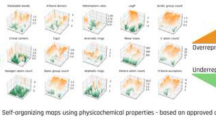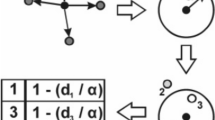Abstract
Using a self-organizing map (SOM) and support vector machine, two classification models were built to predict whether a compound is a selective inhibitor toward the two Acyl-coenzyme A: cholesterol acyltransferase (ACAT) isozymes, ACAT-1 and ACAT-2. A dataset of 97 ACAT inhibitors was collected. For each molecule, the global descriptors, 2D and 3D property autocorrelation descriptors and autocorrelation of surface properties were calculated from the program ADRIANA.Code. The prediction accuracies of the models (based on the training/ test set splitting by SOM method) for the test sets are 88.9 % for SOM1, 92.6 % for SVM1 model. In addition, the extended connectivity fingerprints (ECFP_4) for all the molecules were calculated and the structure–activity relationship of selective ACAT inhibitors was summarized, which may help find important structural features of inhibitors relating to the selectivity of ACAT isozymes.
Similar content being viewed by others
References
Pols TW, Bonta PI, Pires NM, Otermin I, Vos M, de Vries MR, van Eijk M, Roelofsen J, Havekes LM, Quax PH, Kuilenburg AB, de Waard V, Pannekoek H, de Vries CJ (2010) 6-mercaptopurine inhibits atherosclerosis in apolipoprotein e*3-Leiden transgenic mice through atheroprotective actions on monocytes and macrophages. Arterioscler Thromb Vasc Biol 30: 1591–1597. doi:10.1161/ATVBAHA.110.205674
Ikenoya M, Yoshinaka Y, Kobayashi H, Kawamine K, Shibuya K, Sato F, Sawanobori K, Watanabe T, Miyazaki A (2007) A selective ACAT-1 inhibitor, K-604, suppresses fatty streak lesions in fat-fed hamsters without affecting plasma cholesterol levels. Atherosclerosis 191: 290–297. doi:10.1016/j.atherosclerosis.2006.05.048
Libby P (2005) The forgotten majority: unfinished business in cardiovascular risk reduction. J Am Coll Cardiol 46: 1225–1228. doi:10.1016/j.jacc.2005.07.006
Miyazaki A, Kanome T, Watanabe T (2005) Inhibitors of acyl-coenzyme A: cholesterol acyltransferase. Curr Drug Targets Cardiovasc Haematol Disord 5: 463–469
Lada AT, Davis M, Kent C, Chapman J, Tomoda H, Omura S, Rudel LL (2004) Identification of ACAT1- and ACAT2-specific inhibitors using a novel, cell-based fluorescence assay: individual ACAT uniqueness. J Lipid Res 45: 378–386. doi:10.1194/jlr.D300037-JLR200
Sliskovic DR, Picard JA, Krause BR (2002) ACAT inhibitors: the search for a novel and effective treatment of hypercholesterolemia and atherosclerosis. Prog Med Chem 39: 121–171
Alegret M, Llaverias G, Silvestre JS (2004) Acyl coenzyme A:cholesterol acyltransferase inhibitors as hypolipidemic and antiatherosclerotic drugs. Methods Find Exp Clin Pharmacol 26: 563–586. doi:10.1358/mf.2004.26.7.863738
Meuwese MC, Franssen R, Stroes ES, Kastelein JJ (2006) And then there were acyl coenzyme A:cholesterol acyl transferase inhibitors. Curr Opin Lipidol 17: 426–430. doi:10.1097/01.mol.0000236369.50378.6e
Chang TY, Li BL, Chang CC, Urano Y (2009) Acyl-coenzyme A:cholesterol acyltransferases. Am J Physiol Endocrinol Metab 297: E1–9. doi:10.1152/ajpendo.90926.2008
Chang CC, Huh HY, Cadigan KM, Chang TY (1993) Molecular cloning and functional expression of human acyl-coenzyme A:cholesterol acyltransferase cDNA in mutant Chinese hamster ovary cells. J Biol Chem 268: 20747–20755
Anderson RA, Joyce C, Davis M, Reagan JW, Clark M, Shelness GS, Rudel LL (1998) Identification of a form of acyl-CoA:cholesterol acyltransferase specific to liver and intestine in nonhuman primates. J Biol Chem 273: 26747–26754. doi:10.1074/jbc.273.41.26747
Parini P, Davis M, Lada AT, Erickson SK, Wright TL, Gustafsson U, Sahlin S, Einarsson C, Eriksson M, Angelin B, Tomoda H, Omura S, Willingham MC, Rudel LL (2004) ACAT2 is localized to hepatocytes and is the major cholesterol-esterifying enzyme in human liver. Circulation 110: 2017–2023. doi:10.1161/01.CIR.0000143163.76212.0B
Ohshiro T, Tomoda H (2011) Isoform-specific inhibitors of ACATs: recent advances and promising developments. Future Med Chem 3: 2039–2061. doi:10.4155/fmc.11.158
Tardif JC, Gregoire J, L’Allier PL, Anderson TJ, Bertrand O, Reeves F, Title LM, Alfonso F, Schampaert E, Hassan A, McLain R, Pressler ML, Ibrahim R, Lesperance J, Blue J, Heinonen T, Rodes-Cabau J (2004) Effects of the acyl coenzyme A:cholesterol acyltransferase inhibitor avasimibe on human atherosclerotic lesions. Circulation 110: 3372–3377. doi:10.1161/01.CIR.0000147777.12010.EF
Nissen SE, Tuzcu EM, Brewer HB, Sipahi I, Nicholls SJ, Ganz P, Schoenhagen P, Waters DD, Pepine CJ, Crowe TD, Davidson MH, Deanfield JE, Wisniewski LM, Hanyok JJ, Kassalow LM (2006) Effect of ACAT inhibition on the progression of coronary atherosclerosis. N Engl J Med 354: 1253–1263. doi:10.1056/NEJMoa054699
Meuwese MC, de Groot E, Duivenvoorden R, Trip MD, Ose L, Maritz FJ, Basart DC, Kastelein JJ, Habib R, Davidson MH, Zwinderman AH, Schwocho LR, Stein EA (2009) ACAT inhibition and progression of carotid atherosclerosis in patients with familial hypercholesterolemia: the CAPTIVATE randomized trial. JAMA 301: 1131–1139. doi:10.1001/jama.301.11.1131
Cho KH, An S, Lee WS, Paik YK, Kim YK, Jeong TS (2003) Mass-production of human ACAT-1 and ACAT-2 to screen isoform-specific inhibitor: a different substrate specificity and inhibitory regulation. Biochem Biophys Res Commun 309: 864–872. doi:S0006291X03016796
Ohshiro T, Matsuda D, Sakai K, Degirolamo C, Yagyu H, Rudel LL, Omura S, Ishibashi S, Tomoda H (2011) Pyripyropene A, an acyl-coenzyme A:cholesterol acyltransferase 2-selective inhibitor, attenuates hypercholesterolemia and atherosclerosis in murine models of hyperlipidemia. Arterioscler Thromb Vasc Biol 31: 1108–1115. doi:10.1161/ATVBAHA.111.223552
Alger HM, Brown JM, Sawyer JK, Kelley KL, Shah R, Wilson MD, Willingham MC, Rudel LL (2010) Inhibition of acyl-coenzyme A:cholesterol acyltransferase 2 (ACAT2) prevents dietary cholesterol-associated steatosis by enhancing hepatic triglyceride mobilization. J Biol Chem 285: 14267–14274. doi:10.1074/jbc.M110.118422
Sakai K, Ohte S, Ohshiro T, Matsuda D, Masuma R, Rudel LL, Tomoda H (2008) Selective inhibition of acyl-CoA:cholesterol acyltransferase 2 isozyme by flavasperone and sterigmatocystin from Aspergillus species. J Antibiot (Tokyo) 61: 568–572. doi:10.1038/ja.2008.76
Jeong TS, Kim KS, Yu H, Kim MJ, Cho KH, Choi YK, Kim HC, Park HY, Lee WS (2005) Saucerneol B derivatives as human acyl-CoA: cholesterol acyltransferase inhibitors. Bioorg Med Chem Lett 15: 385–388. doi:10.1016/j.bmcl.2004.10.066
Liew CY, Ma XH, Liu X, Yap CW (2009) SVM model for virtual screening of Lck inhibitors. J Chem Inf Model 49: 877–885. doi:10.1021/ci800387z
Wang Z, Yan A (2011) Discriminating of HMG-CoA reductase inhibitors and decoys using self-organizing maps. Mol Divers 15: 655–663. doi:10.1007/s11030-010-9288-8
Hao M, Li Y, Wang Y, Zhang S (2011) A classification study of human beta(3)-adrenergic receptor agonists using BCUT descriptors. Mol Divers 15: 877–887. doi:10.1007/s11030-011-9321-6
Yan A, Wang M, Wang K, Yu C (2012) Classification of HCV NS5B polymerase inhibitors using support vector machine. Int J Mol Sci 13: 4033–4047. doi:10.3390/ijms13044033
Yan A, Nie X, Wang K, Wang M (2012) Classification of Aurora kinase inhibitors by self-organizing map (SOM) and support vector machine (SVM). Eur J Med Chem. http://10.1016/j.ejmech.2012.06.037
Ohshiro T, Rudel LL, Omura S, Tomoda H (2007) Selectivity of microbial acyl-CoA: cholesterol acyltransferase inhibitors toward isozymes. J Antibiot (Tokyo) 60: 43–51. doi:10.1038/ja.2007.6
Matsuda D, Ohte S, Ohshiro T, Jiang W, Rudel L, Hong B, Si S, Tomoda H (2008) Molecular target of piperine in the inhibition of lipid droplet accumulation in macrophages. Biol Pharm Bull 31: 1063–1066. doi:10.1248/bpb.31.1063
Ohshiro T, Ohte S, Matsuda D, Ohtawa M, Nagamitsu T, Sunazuka T, Harigaya Y, Rudel LL, Omura S, Tomoda H (2008) Selectivity of pyripyropene derivatives in inhibition toward acyl-CoA:cholesterol acyltransferase 2 isozyme. J Antibiot (Tokyo) 61: 503–508. doi:10.1038/ja.2008.67
Ohshiro T, Matsuda D, Nagai K, Doi T, Sunazuka T, Takahashi T, Rudel LL, Omura S, Tomoda H (2009) The selectivity of beauveriolide derivatives in inhibition toward the two isozymes of acyl-CoA: cholesterol acyltransferase. Chem Pharm Bull (Tokyo) 57: 377–381. doi:JST.JSTAGE/cpb/57.377
Yamazaki H, Omura S, Tomoda H (2009) Pentacecilides, new inhibitors of lipid droplet formation in mouse macrophages produced by Penicillium cecidicola FKI-3765-1: II. Structure elucidation. J Antibiot (Tokyo) 62: 207–211. doi:10.1038/ja.2009.19
MOE Version 2008.10 (2012) Chemical Computing Group Inc. http://www.chemcomp.com [CP/OL]. Accessed July 2012
SONNIA Software (2010) version 4. Molecular Networks GmbH: Erlangen
Sadowski JGJ (1993) From atoms and bonds to three-dimensional atomic coordinates: automatic model builders. J Chem Rev 93: 2567–2581. doi:10.1021/cr00023a012
ADRIANA.Code, Molecular Networks GmbH, Erlangen. http://www.molecular-networks.com
Lipinski CA, Lombardo F, Dominy BW, Feeney PJ (2001) Experimental and computational approaches to estimate solubility and permeability in drug discovery and development settings. Adv Drug Deliv Rev 46: 3–26. doi:S0169-409X(00)00129-0
Petitjean M (1992) Applications of the radius-diameter diagram to the classification of topological and geometrical shapes of chemical compounds. J Chem Inf Comput Sci 32: 331–337. doi:10.1021/ci00008a012
Todeschini RCV (2000) Handbook of molecular descriptors, vol 11. Weinheim, Wiley-VCH
Wagener M, Sadowski J, Gasteiger J (1995) Autocorrelation of molecular surface properties for modeling corticosteroid binding globulin and cytosolic Ah receptor activity by neural networks. J Am Chem Soc 117: 7769–7775. doi:10.1021/ja00134a023
Teckentrup A, Briem H, Gasteiger J (2004) Mining high-throughput screening data of combinatorial libraries: development of a filter to distinguish hits from nonhits. J Chem Inf Comput Sci 44: 626–634. doi:10.1021/ci034223v
Rodgers JL, Nicewander WA (1988) Thirteen ways to look at the correlation coefficient. Am Stat 42: 59–66
Ivanenkov YA, Savchuk NP, Ekins S, Balakin KV (2009) Computational mapping tools for drug discovery. Drug Discov Today 14: 767–775. doi:10.1016/j.drudis.2009.05.016
Wang L, Wang Z, Yan A, Yuan Q (2011) Classification of Aurora-A kinase inhibitors using self-organizing map (SOM) and support vector machine (SVM). Mol Inform 30: 35–44. doi:10.1002/minf.201000106
Hu X, Yan A (2012) In Silico models to discriminate compounds inducing and noninducing toxic myopathy. Mol Inform 31: 27–39. doi:10.1002/minf.201100067
SONNIA can be obtained from Molecular Networks GmbH, Erlangen. http://www.molecular-networks.com. Accessed Juy 2012
Cortes C, Vapnik V (1995) Support-vector networks. Mach Learn 20: 273–297
Chang CC, Lin CJ (2001) LIBSVM: a library for SVM. Software. http://www.csie.ntu.edu.tw/~cjlin/libsvm
Rogers D, Hahn M (2010) Extended-connectivity fingerprints. J Chem Inf Model 50: 742–754
Bender A, Jenkins JL, Scheiber J, Sukuru SCK, Glick M, Davies JW (2009) How similar are similarity searching methods? A principal component analysis of molecular descriptor space. J Chem Inf Model 49: 108–119. doi:10.1021/ci800249s
Author information
Authors and Affiliations
Corresponding authors
Rights and permissions
About this article
Cite this article
Wang, L., Wang, M., Yan, A. et al. Using self-organizing map (SOM) and support vector machine (SVM) for classification of selectivity of ACAT inhibitors. Mol Divers 17, 85–96 (2013). https://doi.org/10.1007/s11030-012-9404-z
Received:
Accepted:
Published:
Issue Date:
DOI: https://doi.org/10.1007/s11030-012-9404-z




